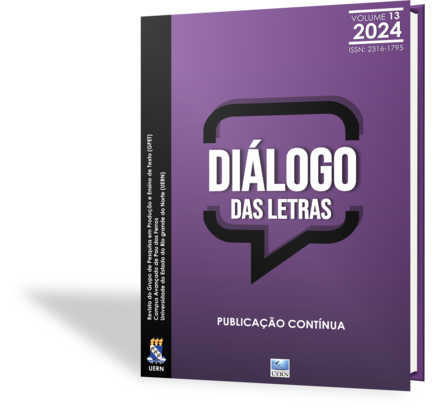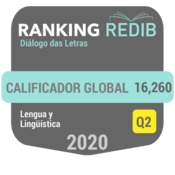Metáforas conceptuais sobre o amor romântico em Romeu e Julieta, de William Shakespeare
DOI:
https://doi.org/10.22297/2316-17952024v13e02423Keywords:
Metaphor, William Shakespeare, Conceptual Metaphor TheoryAbstract
Due to its potential of enlightening and creating meaning, metaphor is one of the most studied and most discussed figures of speech in works from a wide range of fields of knowledge, from literary theory to psychology and cognitive linguistics. Even though many critics and literary theorists have elaborated on the nature and function of this fascinating and intriguing figure of speech, it is argued that it still maintains its relevance as an object of study, given it can shape, to a certain extent, the way we see and experience the world. In this sense, the present article aims to analyze the metaphorical constructions about the concept of romantic love in William Shakespeare's play Romeo and Juliet, through the theoretical framework from the fields of literary theory and cognitive linguistics, with an emphasis on Max Black's (1962;1993), Paul Ricoeur's (1987) and Lakoff and Johnson's (2002) contributions. As an abstract concept, the notion of love does not allow enclosure in a single meaning, an aspect that has been elucidated in the analysis of the various conceptual metaphors in Shakespeare's play. Through Lakoff and Johnson's (2002) considerations, it is argued that there are also contrasting perspectives regarding love in the play, such as through the contrasting images of light and darkness. Thus, this article aims to contribute to critical research regarding the study of metaphor and, more specifically, on its potential for creating meaning.
Downloads
References
BEARDSLEY, M. The metaphorical twist. Philosophy and Phenomenological Research, v. 22, n. 3, p. 293-307, mar. 1962. DOI: https://doi.org/10.2307/2104415. Disponível em: https://www.jstor.org/stable/2104415. Acesso em: 26 nov. 2023.
BEARDSLEY, M. O desvio metafórico. Tradução de Carlos André Fernandes. Fundamento – Revista de Pesquisa em Filosofia, n. 10, p. 87-103, 2015 [1962]. Disponível em: https://periodicos.ufop.br/fundamento/article/view/2438. Acesso em: 26 nov. 2023.
BLACK, M. Models and metaphors. New York: Cornell University Press, 1962.
BLACK, M. More about metaphor. In: ORTONY, A. (ed.). Metaphor and thought. New York: Cambridge University Press, 1993. p. 19-41.
FRYE, N. Sobre Shakespeare. Tradução de Simone Lopes de Mello. São Paulo: EDUSP, 1992.
GIBBS, R. W. Jr. When Is Metaphor? The Idea of Understanding in Theories of Metaphor. Poetics Today, v. 13, n. 4, 1992, p. 575-606. DOI: https://doi.org/10.2307/1773290. Disponível em: https://www.jstor.org/stable/1773290. Acesso em: 21 mar. 2024.
HELIODORA, B. Introdução. In: SHAKESPEARE, W. LEÃO, L. C. (org.). Grandes obras de Shakespeare: Tragédias. Tradução de Bárbara Heliodora. Rio de Janeiro: Nova Fronteira, 2017. p. 11-17.
LAKOFF, G. The contemporary theory of metaphor. In: ORTONY, Andrew (ed.). Metaphor and thought. Cambridge: Cambridge University Press, 1993. p. 202-251.
LAKOFF, G.; JOHNSON, M. Metáforas da vida cotidiana. Tradução de Grupo de Estudos da Indeterminação e da Metáfora (GEIM). São Paulo: EDUC, 2002.
LEVENSON, J. L. The Definition of Love: Shakespeare's Phrasing in "Romeo and Juliet". Shakespeare Studies, v. 15, p. 21-36, 1982. Disponível em: https://www.proquest.com/docview/1297953119?sourcetype=Scholarly%20Journals. Acesso em: 30 nov. 2023.
LI, B. Metaphor, the secret of Shakespeare's success in Romeo and Juliet writing. Frontiers in Educational Research, v. 1, n. 2, p. 24-27, 2018. DOI: https://doi.org/10.25236/FER.030010. Disponível em: https://francis-press.com/uploads/papers/bwB1DPJIf9cMTA468geC5pNmWtSYDKGcNTdQGrWn.pdf. Acesso em: 28 nov. 2023.
RICOEUR, P. A metáfora e o símbolo. In: RICOEUR, P. Teoria da interpretação. Tradução de Artur Morão. Lisboa: Edições 70, 1987. p. 57-81.
SÁNCHEZ, A. B. Metaphorical models of romantic love in Romeo and Juliet. Journal of Pragmatics, v. 24, n. 6, p. 667-688, 1995. DOI: https://doi.org/10.1016/0378-2166(95)00007-F. Disponível em: https://www.sciencedirect.com/science/article/abs/pii/037821669500007F?via%3Dihub. Acesso em: 26 nov. 2023.
SHAKESPEARE, W. Romeu e Julieta. Tradução de Bárbara Heliodora. In: LEÃO, L. C. (org.). Grandes obras de Shakespeare: Tragédias. Rio de Janeiro: Nova Fronteira, 2017 [1597]. p. 19-147.
SIMAN, J. H.; SAMPAIO, T. O. M. Teoria da metáfora conceptual: um dinâmico passo adiante? Revista Porto das Letras, v. 7, n. 1, p. 201-223, 2021. Disponível em: https://sistemas.uft.edu.br/periodicos/index.php/portodasletras/article/view/10576. Acesso em: 25 nov. 2023.
SIMAN, J. H.; SAMPAIO, T. O. M.; GONZALEZ-MARQUEZ, M. How do metaphors shape thought in the wild? Cadernos de Tradução, n. 46, p. 136-156, 2021. Disponível em: https://seer.ufrgs.br/index.php/cadernosdetraducao/article/view/109332. Acesso em: 20 mar. 2024.
Downloads
Published
How to Cite
Issue
Section
License
Copyright (c) 2024 Diálogo das Letras

This work is licensed under a Creative Commons Attribution 4.0 International License.
A Diálogo das Letras não se responsabiliza por conceitos e opiniões emitidos pelos autores, tampouco manifesta, necessariamente, concordância com posições assumidas nos textos publicados. Além disso, os dados e a exatidão das referências citadas no trabalho são de inteira responsabilidade do(s) autor(es). Ao submeterem seus trabalhos, os autores concordam que os direitos autorais referentes a cada texto estão sendo cedidos para a revista Diálogo das Letras; ainda concordam que assumem as responsabilidades legais relativas às informações emitidas.


















